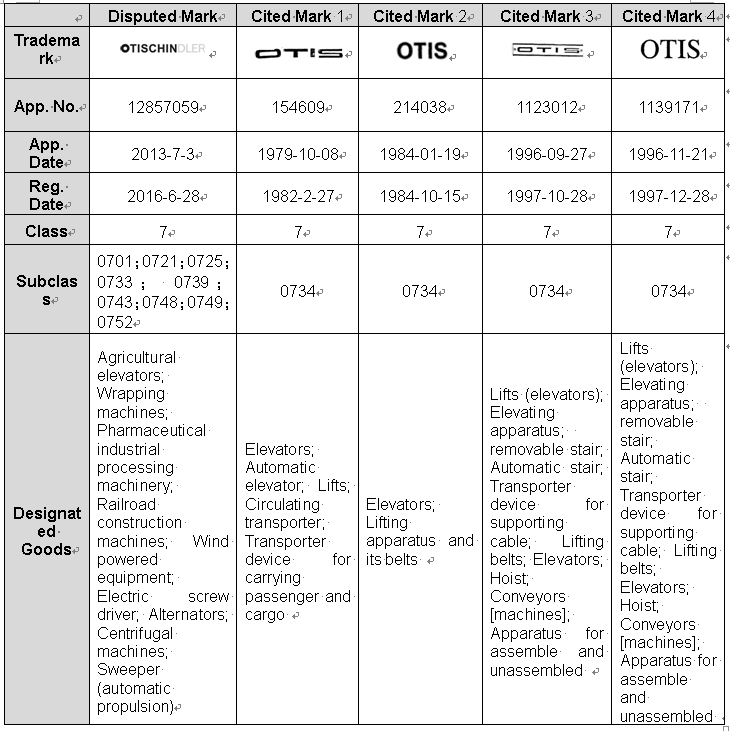
Abstract
We, Kangxin Partners, P.C., filed an invalidation action against the trademark,  (No. 12857059 in Class 7) (“the disputed mark”) on behalf of Otis Elevator Company (“Client”) on December 7, 2017. The National Intellectual Property Administration, PRC (“CNIPA”) examined the case and decided to declare the disputed mark’s registration invalid.
(No. 12857059 in Class 7) (“the disputed mark”) on behalf of Otis Elevator Company (“Client”) on December 7, 2017. The National Intellectual Property Administration, PRC (“CNIPA”) examined the case and decided to declare the disputed mark’s registration invalid.
Backgroud
Otis Elevator Company is the owner of famous brand “OTIS” for elevators, lifting apparatus and other elevating apparatus. Otis Elevator Company registered the trademark “OTIS” in several classes in mainland China, and the trademark “OTIS” over the goods “elevators, lifting apparatus” enjoys high reputation amongst relevant public. The client was of the opinion that the disputed mark is a “similar mark over similar goods” with the client’s mark“  under registration No. 154609,
under registration No. 154609,  under registration No.214038,
under registration No.214038,  under registration No.1123012 and
under registration No.1123012 and  under registration No. 1139171. Upon communication with client, we were entrusted to file invalidation against this trademark.
under registration No. 1139171. Upon communication with client, we were entrusted to file invalidation against this trademark.
The comparison of the marks is as below:

Key issues
We filed invalidation action against the disputed mark on December 7, 2017. In the invalidation, we mainly argued that:
1) The disputed mark is “similar marks over similar goods” with compared to Cited Marks 1-4, in violation of Article 30 of the PRC Trademark Law;
2) The disputed mark is a copy and an imitation of the client’s well-known mark,  (No. 214038), which will easily mislead the public and damage the client’s interests, in violation of Article 13.3 of the PRC Trademark Law;
(No. 214038), which will easily mislead the public and damage the client’s interests, in violation of Article 13.3 of the PRC Trademark Law;
3) The registration of the disputed mark is deceptive, it will mislead the consumers on the quality, origin of the goods;
4) Registration of the disputed mark is in improper means, which violates the principle of good faith and causes negative social influences.
On December 14, 2018, the CNIPA issued the decision: The disputed mark completely contains the cited marks “OTIS”, which enjoys strong distinctiveness, and the disputed mark does not have other meaning, which can make it distinguishable from the cited marks, so these marks are similar marks. The designated goods “agricultural elevators, etc.” of the disputed mark are closely related to the designated goods of the cited marks in terms of function, usage and sales places. In addition, the cited marks have obtained certain reputation in China through promotion; the co-existence of these marks will confuse the relevant public. Therefore, the disputed mark is in violation of Article 30 of Chinese Trademark Law.
Key Point of the Case
The key issue of this case is that 1)the disputed mark is a “similar mark” with the cited marks, and 2) the goods of the disputed mark are similar to those of the designated goods.
With respect to issue 1, the marks of both parties have certain differences in respect of composed letters, overall appearance and pronunciation. Specifically, although the disputed mark’s first four composed letters “OTIS” is same with the composed letters “OTIS” in the cited marks, the disputed mark also contains the word “CHINDLER”, which make the marks have differences with respect to composed letters, overall appearance and pronunciation. However, in the invalidation, we argued that the disputed mark entirely contains the letters “OTIS” cited marks, and these letters are in the distinctive place. In addition, we emphasized in the pleading that the cited marks enjoy strong originality and distinctness, and enjoy high reputation amongst relevant public, under this circumstances, when relevant public sees the disputed mark, it will be easy to connect it to the client and the cited marks, and cause confusion. At the same time, we collected several prior similar precedents to prove the marks’ similarity.
With respect to issue 2, although the goods of the disputed mark are not similar to those of the cited marks in accordance with the Chinese Classification of Goods and Services, because they are in different subclasses. However, we agued from the nature and characteristics of the goods, emphasized that the goods are closely related in respect to function, use purpose, manufacturing department, sales channel and target consumers. We also illustrated that when consumers purchase products, they will purchase goods with good quality, since the client’s goods are excellent, consumer is more likely to purchase the disputed mark’s goods. Moreover, a international big company like the client, it is quite reasonable to have several products lines, so the consumers may easily think that the disputed mark and its goods are one of the client’s brand and products lines, so confuse the origin of the goods. Therefore, the disputed mark’s goods should be considered similar to the goods of the cited marks.
Case outcome
On December 14, 2018, the CNIPA issued the decision and decided to declare the disputed mark invalid.


Follow us






